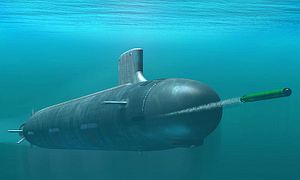The Naval Submarine League held its annual confab last month outside Washington. Silent-service leaders warned – rightly – that senior commanders’ demand for subs far outstrips the supply. And the mismatch is getting worse. The sub force’s plight recalls the old Differential Equations problem in which the bathtub drain is open and the spigot’s open as well … but not wide enough to keep the water level steady. The water slowly empties out. The question is, how fast?
Numbers of attack submarines are the most immediate problem. (Replacing the fleet of ballistic-missile subs threatens to suck the entire U.S. Navy shipbuilding budget dry in the coming decades, but that’s a story for another day.) The navy, that is, is constructing two Virginia-class attack boats per year, but it’s retiring Cold War-vintage Los Angeles-class SSNs even faster. The upshot: a slow drain on the SSN inventory.
Options are few. Congress and the navy can arrest the decline by stepping up new construction, extending the service lives of older units, or finding cheaper ways to execute missions currently entrusted to SSNs.
It’s improbable lawmakers will fund more Virginias amid straitened circumstances. Unmanned underwater vehicles may ultimately supplement the submarine fleet for missions such as anti-submarine warfare. But operational deployment of UUVs remains some ways off. The extent to which they can offset smaller SSN numbers, moreover, remains to be seen. Like all golly-gee new technologies, UUVs have to prove themselves. Which leaves stretching out the lives of Los Angeles-class boats. That’s the least expensive, lowest-risk, likeliest outcome for the near term.
Mass matters. Commentators, myself included, tout undersea warfare as a core advantage over competitors in the Western Pacific and Indian Ocean basin. And this is true on a boat-for-boat basis. But this gives rise to triumphalism, as though an American boat is like a Death Star that can zap entire enemy navies or merchant fleets. It also implies that numbers of boats are unimportant.
Wrong. Though virtually omnipotent, the Death Star has to close to firing range before cutting loose with its laser cannon. So does an attack boat. The skill and derring-do of submariners and the quality of their hardware count for little if they’re too far away or too scattered about to reach their targets.
And the striking range of U.S. SSNs is startlingly short when operating against surface shipping or enemy submarines. Attack subs can be armed with torpedoes, anti-ship cruise missiles, or land-attack cruise missiles. While American boats can fire Harpoon anti-ship missiles, they seldom carry Harpoons, let alone practice with them. Tomahawks meant for attacking targets ashore fill SSNs’ tubes.
There are opportunity costs to power projection. Sea denial and control are afterthoughts for navies obsessed with it. Skills atrophy. That indictment has fit the U.S. Navy for two-plus decades now, as we ancient mariners will attest.
Think about how optimizing the weapons complement for power projection foreshortens a boat’s range. Pick a point out at sea on your favorite nautical chart. You landlubbers should all have compasses. If not, cut a piece of string to measure 60 nautical miles (1 degree of latitude = 60 nautical miles). Pin one end of the string to your point on the map, and use the other end to trace a circle around that centerpoint. You’ve sketched the approximate area coverage for Harpoon engagements.
Now cut the string in half and do the same thing. That gives you a generous (very, very generous) estimate of our hypothetical SSN’s reach with Mark 48 torpedoes, the anti-ship weapons usually found in the fleet today. See what happened? The area of a circle varies by the square of the radius … so halving the range of a ship’s armament cuts the area it can reach not by half but by a factor of four. Geometry is a harsh mistress. Subs outfitted with short-range weaponry must operate in tight proximity to one another to concentrate fire at vital points on the map. That means you need more SSNs – however sterling the quality of any given boat or crew may be.
Think about Corbett’s thumb rule for “elastic concentration” of a fleet, whereby ships disperse as much as possible provided they remain close enough to one another to render mutual support. SSNs armed with ASCMs can disperse far more widely than boats sporting torpedoes. Ergo, fewer boats can cover the same space. Weapons range is a force multiplier.
Recommendations? First: by all means, let’s build more boats. The undersea fleet is far too small. Let’s not console ourselves with the gadgetry being deployed at sea, or assume that such fudge factors will make up for brute numbers. Prospective adversaries are improving their material prowess as well. In particular, elusive diesel boats suitable for offshore picket duty — most equipped with ASCMs outranging the Harpoon — are proliferating. The U.S. Navy is not competing against a potted plant.
Second: let’s restore Harpoons to SSNs’ panoply pronto while replacing the Harpoon — a bird with very modest range and payload by today’s standards — with something more lethal. One hopes a subsurface-launched ASCM – a successor to the long-ago, very-long-range Tomahawk Anti-Ship Missile – ranks high on the navy’s priorities list. Again, combat reach ameliorates many problems.
And third: until the halcyon days of a big undersea fleet with a long arm arrive, commanders should consider where to position their boats for maximum effect. If the striking range of submarines is too short, all the more important to deploy them at what Corbett terms “focal areas” on the map. That could mean the origins and destinations of ships’ voyages. Mainly, though, Corbett means straits and other passages where islands, coastlines, and underwater topography funnel shipping into narrow lanes — lanes that one or a few subs can oversee.
A submarine is lethal indeed within its range. Let’s use geography to offset its limitations – while striving to overcome those limitations. Dive!

































